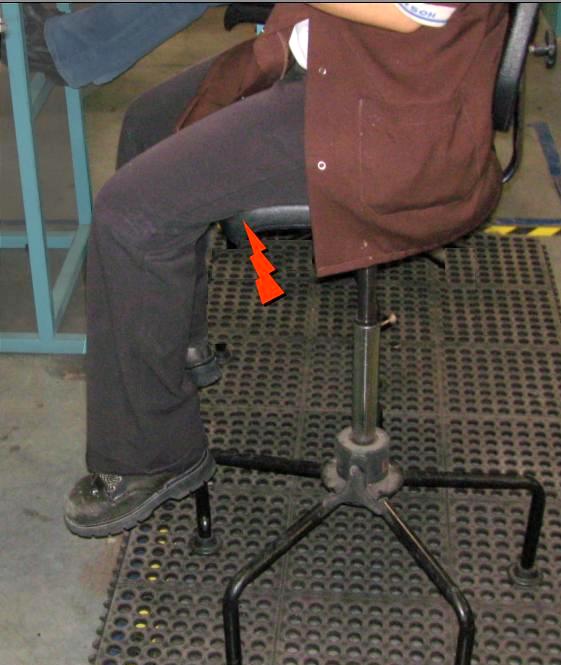 |
 |
| Pressure points behind the knees | Instinctive need for any type of change in position |
Background
There are several reasons why footrests can be helpful:
Sitting:
- When the feet do not reach the floor, the weight of the legs creates pressure points behind knees. The foot rest provides support to eliminate the pressure.
- Even in situations where the feet reach the floor, a footrest can help provide something to push against to help position the body into the chair. (This factor is subtle and less important than the other reasons listed here.)
Standing:
- Constant standing in the same position is fatiguing to leg muscles . A footrest provides an opportunity to move the legs into different positions to relieve the fatigue.
- A foot rest helps keep at least one of the knees bent occasionally, which helps reduce strain on the lower back.
- Note that footrests are not appropriate or feasible when a person moves from place to place. However, when standing in the same position for a period of time, a footrest can be helpful.
Note that in many common situations, the same footrest can be used for both sitting and standing. Optimal height depends upon the height of the individual and the application, but generally a height around 8 in. is used.
Objectives
Maintain the principles regarding pressure points and movement. In other words, a footrest in and of itself is not ergonomic. It is just a common way to achieve the principles.
Ideas and Options
Box
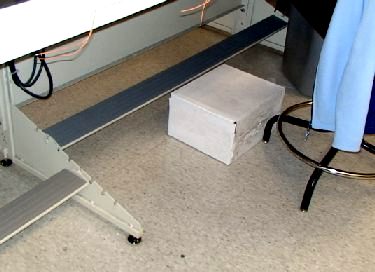 |
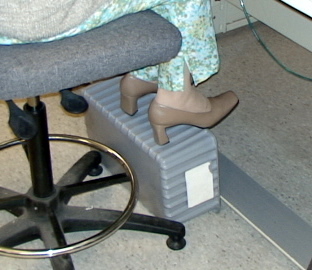 |
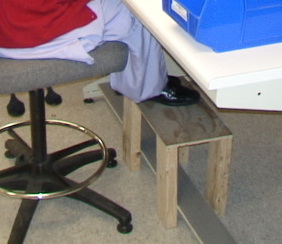 |
| Cardboard box | Tote container on side | Plywood platform |
Footrests can be as simple as a stiff cardboard box, a parts container turned on its side, or a homemade plywood platform. From a scientific viewpoint, these improvised supports often serve the purpose. However, aesthetically they may not look professional and some may lack proper stability.
Step stools
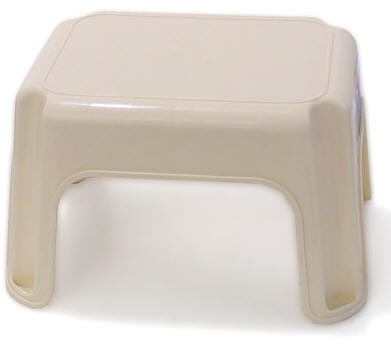 |
| Inexpensive plastic step stool |
There are many inexpensive, commercially available step stools that can serve as workstation foot rests. One of the shortcomings of any of these stand-alone footrests is that they can add to congestion. They are also easy to inadvertently kick out of reach.
Rocking
 |
| Rocking style footrest |
One of the newer styles of footrests on the market provides tilt capabilities and can be rocked back and forth, which helps stretch muscles and reduce fatigue. The design is both elegant and simple, with a price of about $50.
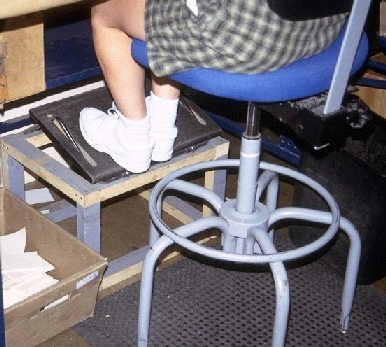 |
| Combination of all of the above |
Adjustable height
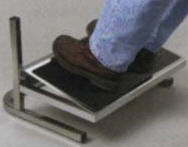 |
| Slanted adjustable platform footrest |
The type of footrest that is generally considered to be top-of-the-line provides height adjustment to accommodate different individuals and different height chairs. It is also slanted, which can help seat the employee in the chair better plus help keep the foot in its typical posture relative to the lower leg. The cost is about $150.
 |
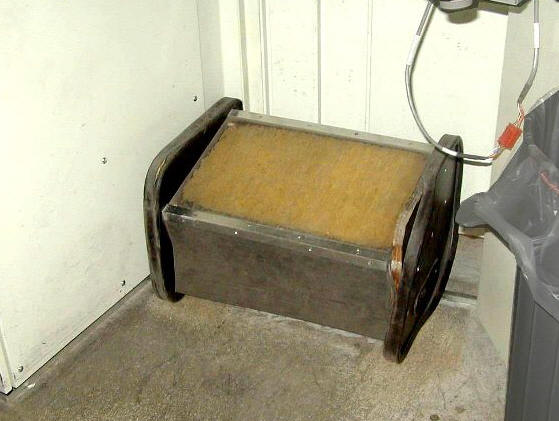 |
| Side 1 up — lower | Side 2 up — higher |
The design of this footrest cleverly provides three different heights depending on which side it is turned. Commercial availability is unknown, but this design could be easily homemade.
Chair ring
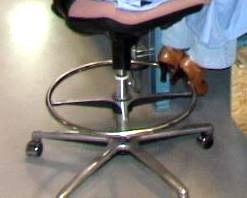 |
| Adjustable chair ring |
Many shop chairs have a ring footrest, which can be helpful. However, usually an additional footrest is needed, since it can be uncomfortable to hold the legs in a backward position (or indeed any single position) for a long period of time. The ring provides another place to move the feet, change position, and reduce fatigue, but it is usually not sufficient by itself. A common problem is that employees are often not aware that the ring can be adjusted. Typically, a short meeting or safety talk is needed to show everyone how to raise the ring.
Built-in
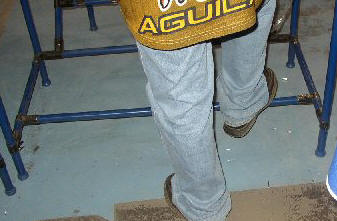 |
 |
| Built-in rail | Built-in flat surface |
Often the best approach in designing workstations is to build in the foot rest. Usually it can be incorporated into the frame with very little additional cost, if any.
Comments
Rails vs. flat surfaces
The above photos on built-in foot rests help show an additional point. A rail can be used, but it can create a pressure point on the foot. A flat surface is better.
Instinctive when standing
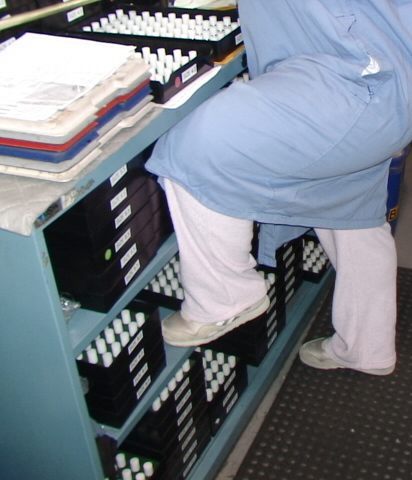 |
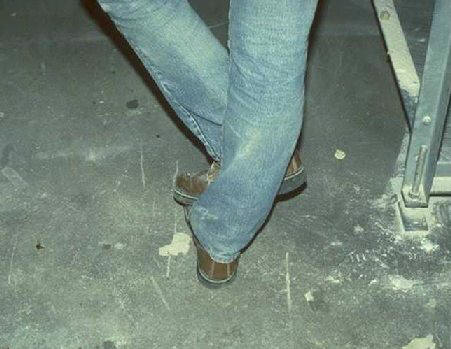 |
| Unconscious attempts to use a footrest | |
When people stand in the same place for a long time, it is instinctive to find something to rest a foot on. When nothing is available, putting one foot on top of the other is better than nothing. The change in position helps relieve fatigue in the legs.
Benefits for the spine
 |
| Footrests help the spine and reduce leg fatigue |
Footrests can help the lower back. The optimal neutral posture of the back is obtained with the knees slightly bent. A widely recognized application of this principle is when doing sit-ups for exercise. A generation ago, the normal practice was to keep the legs straight. Now we are instructed to keep the knees bent, since it is easier on the spine.
The ability to change positions of the legs also helps to prevent leg fatigue.
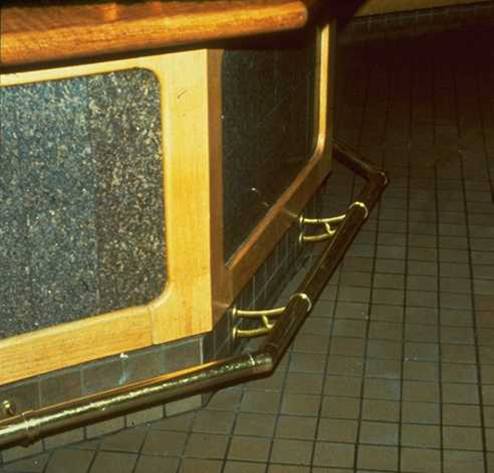 |
| Brass rail reduces fatigue from standing for long periods |
The tavern industry learned about the importance of foot rests long ago. Fatigued customers go home. The rail makes it more comfortable to stay and buy more beer.
